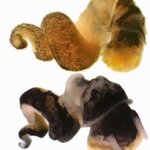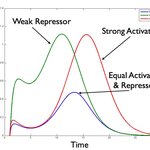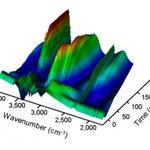Genetics & Molecular Biology

As antibiotic resistances continue evolve in a smaller world they become a more difficult problem to eradicate.
Acquisition of mutations is one of the ways by which bacteria become resistant to antibiotics. But this comes with a cost: although crucial for bacteria survival in a medium with antibiotics, in its absence bacteria growth rate is reduced. Although it is not possible to impaired bacteria to evolve and adapt to the environment, it is possible to choose the type of selective pressure (antibiotics) to administrate and, in this way, alter the course of evolution to our favor.
A new…

Talk to any molecular biologist, and you'll find that most of them feel that there is something that we're missing when we analyze complex biological systems. These systems are often too difficult to reason about verbally in any sort of detailed or rigorous way. So we build mathematical models, sometimes going to great effort to perform very precise measurements so that we can properly parameterize our models.
But at this point we frequently run into a problem: we have no clue what questions to ask with the model. The issue is not that we lack questions; it's that we have a hard time picking…

There's a coevolutionary struggle between a New Zealand snail and its worm parasite but it ends up being sexually advantageous for the snail, whose females favor asexual reproduction in the absence of parasites, according to scientists who say their report represents direct experimental evidence for the "Red Queen Hypothesis" of sex, suggesting sexual reproduction allows host species to avoid infection by their coevolving parasites by producing genetically variable offspring.
They say their Current Biology report also supports the "Geographic Mosaic Theory," meaning natural selection need not…

One of my recently developed rules: avoid the last minute rush. I don't run to catch the Metro train, and I don't scramble to put my data into some sort of coherent form when I have to give a lab meeting presentation on short notice.
So I'm not scrambling for my lab meeting talk tomorrow. My plan is, in the absence of any solid results to present, to go visionary, saying whatever I want to, without having to back it up with supporting data. And in the spirit of scientific openness, I'm providing a sneak preview of what may tomorrow turn out to be a terrific mess of a lab meeting talk.
Why…

I assume all of you know this but, if not, here is the blurb I keep getting from the kind marketing folks at Science.
The upside: $25,000
The catch: The topic is limited to molecular biology.
The criteria: This is for 'early career life scientists' so you may be excited, since the average age is now 42 years old before getting an R01 grant but, no, they mean only those who were awarded their Ph.D. in 2008. So the only ones eligible are what you researchers call 'slave labor'.
What you need to do: Craft a 1,000 word essay about your work. Get a letter from your…

In all the talk about using skin cells to create pluripotent stem cells that don't need human embryonic destruction, dental and tissue engineering researchers at Tufts University School of Dental Medicine and the Sackler School of Graduate Biomedical Sciences have gone the other way and used human embryonic stem cells (hESCs) to generate complex tissues that mimic human skin and the oral mucosa (the moist tissue that lines the inside of the mouth).
Their proof-of-concept study is published in Tissue Engineering Part A.
Using a combination of chemical nutrients and specialized surfaces…

How do individual cells survive conditions that should kill them? It's long been a mystery of nature but a team of researchers recently tracked the chemical changes in Desulfovibrio vulgaris, which is a single-cell bacterium that normally can only exist in an oxygen-free environment. They exposed the cells to the most hostile of conditions — air — and watched as some cells temporarily survived by initiating a well-orchestrated sequence of chemical events.
Until now, scientists have not been able to monitor, at a molecular level, the chemical changes in individual cells as they survive…

Researchers writing in Proceedings of the National Academy of Sciences say they have discovered that the sea lamprey, which emerged from jawless fish first appearing 500 million years ago, dramatically remodels its genome. Shortly after a fertilized lamprey egg divides into several cells, the growing embryo discards millions of units of its DNA - one fifth of its genome.
They say this is the first recorded observation of a vertebrate extensively reorganizing its genome as a normal part of development. A few invertebrate species, like some roundworms, have been shown to undergo extensive…

Scientists writing in Developmental Cell say they have identified a master regulator gene for early embryonic development of the pancreas and other organs, putting researchers closer to coaxing stem cells into pancreatic cells and then a possible cure for Type 1 Diabetes.
They say this discovery reverses a long standing belief that the biliary system's origin is connected to early embryonic formation of the liver, the researchers said. The pancreas regulates digestion and blood sugar, and the biliary system is vital for digestion. If the organs do not form properly during fetal development,…

A new micro-tool allows researchers to measure and manipulate cellular forces as assemblies of living cells reorganize themselves into tissues. The new technique allows researchers to gauge how cells' minute mechanical forces affect cellular behavior and cell differentiation in a 3-D, in vivo-like environment. It mimics how tissue actually forms in a living organism.
The push-and-pull of cellular forces drives the deformation, extension and contraction of cells that occur during tissue development and these processes ultimately shape the architecture of tissues so how it is done…